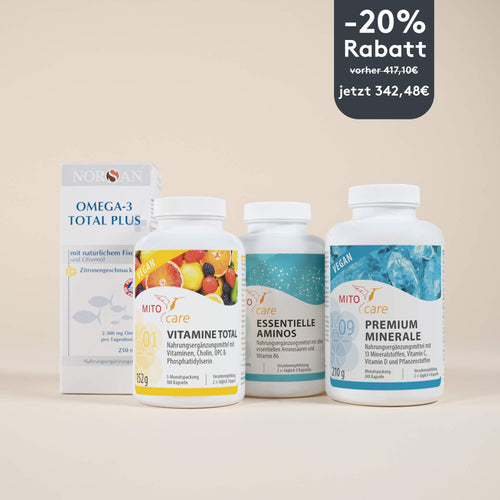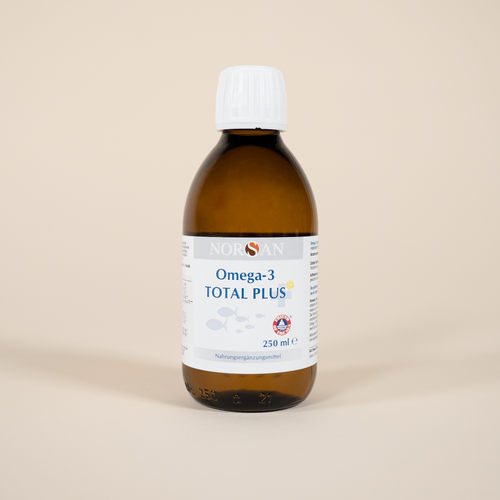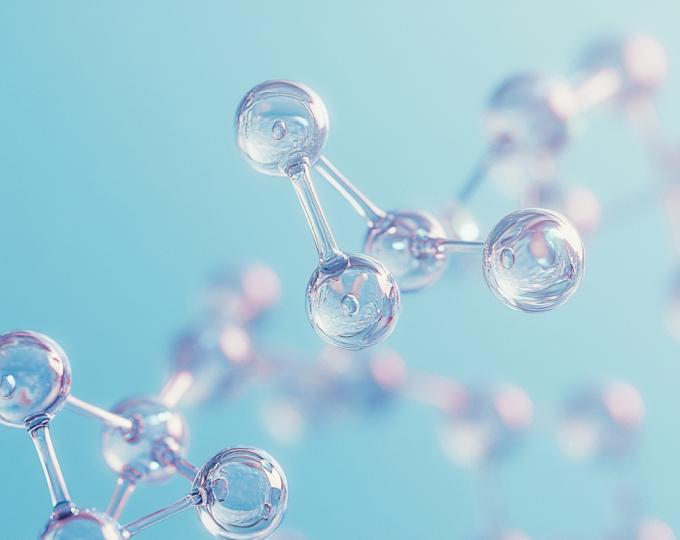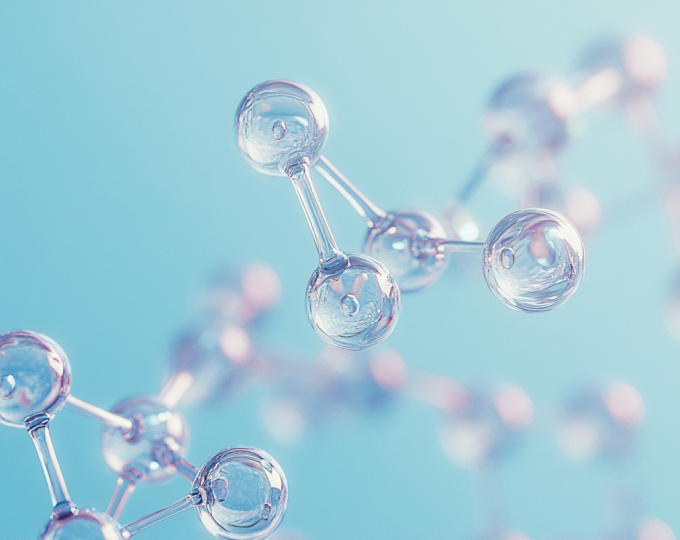Themen dieses Blogartikels:
Table of contents
- Muscle building: The basics
- Training and strain
- Nutrition and macronutrients
- The role of epigenetics
- What is epigenetics?
- PGC-1: The king signaling pathway
- VDR: Vitamin D receptor
- Nucleotides: the forgotten nutrients
- Importance of nucleotides
- Sources and requirements
- Mitochondria: The power plants of the cells
- Importance of mitochondria
- Promoting mitochondrial health
- Galactose & Carnitine
- Practical applications & specific recommendations
- Training strategies for maximum muscle growth
- Nutrition tips for optimal muscle building
- Supplementation for maximum success
- Specific nutrients for muscle building
- Essential amino acids and BCAAs
- Requirements and supplementation
- Too much protein can also be counterproductive
- Clever combination products with amino acids and nucleotides make the difference
- Bibliography
Muscle building: The basics
Training and strain
Targeted exercise is essential to build muscle mass. Training stimulates your muscle cells to increase their compensatory capacity. This happens through the activation of certain genes that are responsible for energy supply (metabolic adaptation) and cell growth (morphological adaptation). Effective training leads to supercompensation, where the intervals and intensity of training are optimized to achieve the best results.
Supercompensation is a central concept in muscle building. It describes the process by which your body not only returns to its initial level after a training load, but also increases its performance beyond this. This effect occurs when the regeneration phases are used optimally and sufficient nutrients are available. The trick is to find the right timing for exercise and recovery in order to achieve continuous progress.
Another important aspect is training intensity. To stimulate muscle growth, training must have a certain intensity. This can be achieved by using heavy weights, high repetitions or short breaks between sets. Your muscles need to be challenged in order to grow. Too light a load will not lead to the desired adaptations.
Nutrition and macronutrients
An adequate supply of anabolic macronutrients, especially protein, is essential for muscle building. Proteins consist of amino acids, which serve as building blocks for muscle tissue. The optimal weighting of individual amino acids is often disputed, but the fundamental importance of protein for muscle building is generally recognized. Equally important are micronutrients such as trace elements, electrolytes and vitamins, which act as “lubricating oil” in cell metabolism.
Protein is the most important macronutrient for muscle building. It provides the necessary amino acids for protein synthesis, the process by which new muscle proteins are formed. Your daily protein requirement can vary depending on the intensity and volume of your training. In general, an intake of 1.6 to 2.2 grams of protein per kilogram of body weight is recommended. This requirement may be even higher for strength athletes.
Carbohydrates are also important as they are the main source of energy for intensive training. Adequate carbohydrate intake ensures that the glycogen stores in your muscles are filled and therefore sufficient energy is available for hard training sessions. Fats play a role in hormone production, especially in the synthesis of testosterone, which is essential for muscle building.
The role of epigenetics
What is epigenetics?
Epigenetics refers to the mechanisms that determine which genes are activated at what time and in what combination. This fine control can be compared to a piano, where the limited number of keys allows for an almost infinite variety of melodies. Two signaling pathways in particular are important for muscle development: PGC-1 and VDR. Epigenetic changes can be influenced by various external factors such as diet, environment and training. These changes are not permanent and can adapt over time, which means that you can achieve positive effects on muscle building through certain lifestyle changes.
PGC-1: The king signaling pathway
PGC-1 is activated by the consumption of muscular energy reserves and initiates the formation of new mitochondria and muscle fibers¹. This can be promoted not only by training, but also by cold (heat production). Negative influences on this signaling pathway include increasing age, hypercaloric nutrition, obesity and silent inflammation, which can be triggered or worsened by overtraining².
PGC-1 is a coactivator that regulates the expression of genes involved in energy production and oxidative metabolism. By activating this signaling pathway, more mitochondria can be formed in your muscle cells, leading to higher energy production and improved endurance. Cold exposure and intense training can stimulate this signaling pathway and thus promote muscle building.Silent inflammation is a state of chronic, low-grade inflammation that often goes unnoticed. It can be triggered by various factors such as stress, poor nutrition and overtraining.
Silent inflammation can hinder muscle development and increase the risk of injury.³ It is therefore important to minimize inflammation in your body and prevent it through a balanced diet and sufficient recovery. An additional intake of polyphenols such as quercetin, EGCG, astaxanthin and resveratrol also makes sense in this context.⁴
VDR: Vitamin D receptor
The VDR signaling pathway is also crucial for muscle building. Vitamin D has long been known for its importance in muscle metabolism, but the functionality of the vitamin D receptor also plays an important role. A lack of vitamin D leads to a decrease in muscle mass and an increased risk of injury.⁵ However, it is not only the level of vitamin D that is crucial, but also the availability and function of the VDR, which regulates the target genes. A deficit in the functionality of the VDR can reduce the anabolic capacity of your muscle cells and increase the risk of inflammation. Incidentally, it is known that even among professional athletes a vitamin D deficiency is widespread (approx. 30%), or a suboptimal vitamin D supply.⁶
Vitamin D acts via the VDR and influences gene expression in your muscle cells.⁷ The VDR is present in many tissues of the body and regulates a variety of processes, including calcium balance, immune function and muscle health. Optimal vitamin D levels and good VDR function are therefore crucial for muscle building.
Advertisment
Vitamin A, D3, E & K2 in high-quality coconut & olive oil (fat-soluble vitamins)
50.00 µg vitamin D3 per drop
Synergetic combination of active ingredients increases usability in the body
Good for immune system, cell protection, skin & mucous membranes
Particularly important during the cold season

Nucleotides: the forgotten nutrients
importance of nucleotides
Nucleotides are essential components of our DNA and RNA and therefore carry our genetic information. They are essential for gene activation and energy production in our cells. They are particularly important for muscle building, as they provide the blueprints and construction machinery for protein synthesis. Studies show that the combined administration of nucleotides and amino acids is superior to the supply of protein alone.
Nucleotides play a key role in many biological processes. They are the building blocks of nucleic acids (DNA and RNA) and are involved in energy storage and transfer. Adenosine triphosphate (ATP), the primary energy transfer molecule in cells, also consists of nucleotides. A sufficient supply of nucleotides is therefore crucial for efficient protein synthesis and energy production in your muscle cells. Studies even show that a combined administration of amino acids and nucleotides is clearly superior to the sole intake of high-dose proteins.⁸
Sources and requirements
Dein Körper kann Nukleotide grundsätzlich selbst herstellen, aber bei erhöhtem Bedarf, wie etwa bei intensivem Training, kann diese Kapazität schnell ausgeschöpft sein. Die Zufuhr durch nukleotidreiche Lebensmittel ist heutzutage weniger üblich, weshalb eine gezielte Supplementation sinnvoll sein kann. Nukleotide fördern nicht nur den Muskelaufbau, sondern erhöhen auch den Spiegel von IGF-1, einem wichtigen Wachstumsfaktor.⁹
Advertisment
The premium nucleotide complex contains all 5 approved nucleotides
Rich in ribonucleic acid (RNA)
Magnesium, zinc, vitamin B12 & bioactive folic acid to support cell division
For DNA synthesis, cell division, immune system & energy
Without fillers or additives
Developed with doctors & experts

Mitochondria: The power plants of the cells
Importance of mitochondria
Mitochondria play a central role in energy production and the control of many cellular processes, including gene expression.¹⁰ Their health and number are crucial for performance and adaptation to training. Overtraining and inadequate supercompensation are often associated with mitochondrial deficiencies.¹¹
Mitochondria are the main energy producers in cells. They convert nutrients into ATP, which serves as an energy source for cellular processes. A high number and quality of mitochondria is crucial for the energy supply of your muscle cells and therefore for physical performance. Training adaptations aimed at improving mitochondrial function can significantly increase endurance and strength.
Advertisment
- Delivers fast: Before or after exercise for performance & recovery
- High-quality caprylic acid (C8) from carefully pressed organic coconut oil
- 100% certified organic quality
- Taste & odor neutral
- Excellent as an addition to coffee, smoothies, dressings, and more
- No fillers or flavors
- Developed with doctors & experts

Promoting mitochondrial health
Optimizing mitochondrial health involves the removal of damaged mitochondria (mitophagy) and the formation of new mitochondria (biogenesis). This can be achieved through various measures such as aerobic exercise, cold applications¹², hypoxia (e.g. altitude training), certain active ingredients (e.g. spermidine¹³, polyphenols¹⁴) and dietary changes (fasting, intermittent fasting¹⁵, ketogenic diet¹⁶). In addition to quality assurance, the provision of sufficient nutrients is also crucial. Important nutrients include, for example, phospholipids, Q10 and carnitine. In addition, phospholipids, alpha lipoic acid, and a variety of amino acids, including taurine, are required. It therefore makes more sense to rely on nutrient combinations that are specifically tailored to the requirements of the mitochondria. This is particularly important as the ratio of the individual components to each other is also of crucial importance.
Mitophagy is the process by which damaged mitochondria are broken down and recycled. This is important to maintain the efficiency of cellular energy production. Biogenesis is the formation of new mitochondria and can be stimulated by regular endurance training and certain nutrients. A healthy mitochondrial population is crucial for the performance and regeneration of your muscle cells.
A holistic approach to promoting mitochondrial health can optimize training adaptations and improve overall health. This includes specific training methods as well as targeted nutrition and supplementation. By combining these strategies, you can maximize your physical performance and achieve your muscle building goals more efficiently.
Galactose & Carnitine
An interesting combination to promote fat burning in the mitochondria is galactose and carnitine. Galactose stimulates the import and burning of fatty acids and reduces the formation of lactate (lactic acid)¹⁹. This combination can increase energy production and improve performance during aerobic exercise.
Galactose is a monosaccharide that can be used as an alternative energy source. It has the advantage of reducing lactate formation and thus delaying muscular fatigue. Carnitine is a compound that is essential for the transport of fatty acids into the mitochondria, where they are burned to produce energy. An adequate intake of carnitine can improve fat burning and energy production in your muscle cells.
Practical applications & specific recommendations
Training strategies for maximum muscle growth
A targeted and varied training program is crucial for your muscle building. It should consist of a combination of strength training, endurance training and specific techniques to improve mitochondrial function. Here are some specific recommendations for you:
- Periodization: a well-structured training plan should include different phases with different goals, e.g. hypertrophy (muscle growth), strength and endurance. By varying the training stimuli, you can achieve optimal adaptation of your muscles.
- Progressive overload: To achieve continuous progress, the training intensity must be gradually increased. This can be achieved by increasing the weight, the number of repetitions or the training frequency.
- Specific exercises: Basic exercises such as squats, deadlifts and bench presses should form the basis of your training program, as they target several muscle groups simultaneously and generate a high mechanical load.
- Recovery & regeneration: Sufficient recovery phases are crucial for your muscle building. This includes not only rest days, but also measures to promote regeneration such as stretching, massages & cold applications.
Nutrition tips for optimal muscle building
A balanced diet rich in proteins, carbohydrates, fats and micronutrients forms the basis for your muscle building. Here are some specific nutrition tips in themselves:
- Protein-rich foods: sources such as meat, fish, eggs, dairy products and plant-based proteins (e.g. pulses, tofu, quinoa) should be regularly included in your diet.
- Nucleotide-rich foods: As already mentioned, offal such as liver and kidneys are good sources of nucleotides. These should be integrated into your diet or supplemented.
- Carbohydrates for energy: Whole grain products, fruit and vegetables provide the energy you need for intensive training sessions and support the regeneration of your glycogen stores.
- Healthy fats: Nuts, seeds, avocados and oily fish provide essential fatty acids that are important for hormone production and cell health.
Supplementation for maximum success
In addition to a balanced diet, certain supplements can support your muscle building:
- Protein supplements: whey protein, casein and plant-based protein powders are convenient options to meet your daily protein needs.
- BCAAs: Especially before and after training, BCAAs can promote muscle protein synthesis and prevent muscle breakdown.17 Creatine: Creatine is one of the best researched supplements and can increase your strength and muscle mass.
- Omega-3 fatty acids: These fatty acids have anti-inflammatory properties and can support your regeneration and general health.
- Vitamins & minerals: Vitamin D, magnesium and zinc in particular play an important role in muscle metabolism and should be supplemented as required.
Specific nutrients for muscle building
Essential amino acids and BCAAs
Amino acids are the basic building blocks of proteins and play a central role in muscle building. Particularly important are the branched-chain amino acids (BCAAs: leucine, isoleucine and valine), which not only promote anabolic processes, but also support mitochondrial biogenesis and increase antioxidant capacity. They protect against microtrauma and muscle damage and directly supply fuel for energy production.
Leucine is the most important BCAA for muscle building as it directly stimulates protein synthesis. Isoleucine and valine support this process and provide additional energy for intensive training sessions.20 A sufficient intake of BCAAs can promote muscle protein synthesis and prevent muscle breakdown during intensive training.
Requirements and supplementation
The need for amino acids in athletes is significantly higher than the generally recommended daily intake. Depending on performance level, protein intake should be increased by up to 100%.²¹ However, high dietary protein intake can present challenges such as increased nitrogen load, insulin release²² and digestive problems. Taking easily absorbable amino acids in the form of supplements can circumvent these problems and improve the efficiency of protein supply.
Too much protein can also be counterproductive
The body often cannot convert the entire amount of protein you consume into useful amino acids. This largely depends on how well your digestive organs are functioning. Problems in the gut, such as irritable bowel syndrome, can lead to less protein being properly utilized. Instead, harmful waste products such as ammonia, indoles, phenols and sulphides can be produced. A very high-protein diet can also have a negative impact on your intestinal flora and cause digestive problems.
Clever combination products with amino acids and nucleotides make the difference
It is therefore advisable to opt for easily digestible amino acids that are specifically tailored to your needs. They are easier for the body to utilize and avoid problems such as an excessive nitrogen load, unnecessary insulin release, hyperacidity and indigestion.
Amino acid supplements can be particularly useful if your needs cannot be met through your normal diet. They are easy to digest and can be quickly absorbed by the body. Especially after training, amino acid supplements can accelerate recovery and support muscle building.
For successful muscle building, it is crucial to take a holistic approach that takes training, nutrition and cell biology into account. The combination of amino acids, nucleotides and epigenetic activators such as polyphenols and vitamin D binding protein can maximize your training effects. Equally important is the support of mitochondrial health through targeted nutrient combinations. This comprehensive approach can not only boost your performance, but also improve your cellular health in the long term. By integrating these findings into your training and diet, you can achieve your muscle building goals more efficiently and sustainably. Try different strategies to find out what works best for your body and adjust your approach accordingly. With patience, discipline and the right support, you can make impressive progress in building muscle.
This article is based on carefully researched sources:
Bibliography & Sources
- Arany. (2008). PGC 1 coactivators and skeletal muscle adaptations in health.
- Cerqueira, M.N. (2020). Inflammatory Effects of High and Moderate Intensity Exercise—A Systematic Review. Front Physiol.
- Ward, L. (2006). PGC 1α: a key regulator of energy metabolism. Advances in Physiology Education.
- Rahman, B. &. (2006). Regulation of inflammation and redox signaling by dietary polyphenols. Biochem Pharmacol.
- Bollen, S.E. (2022). The Vitamin D/Vitamin D receptor (VDR) axis in muscle atrophy and sarcopenia. Cellular signaling.
- Angeline, M.E. (2013). The Effects of Vitamin D Deficiency in Athletes. The American journal of sports medicine.
- Carlberg, C. (2019). Vitamin D: A Micronutrient Regulating Genes. Curr Pharm Des.
- Kulkarni, A.D. (1994). The role of dietary sources of nucleotides in immune function: a review. The Journal of Nutrition.
- Vásquez Garibay, ESV (2006). Effect of nucleotide intake and nutritional recovery on insulin-like growth factor I and other hormonal biomarkers in severely malnourished children. British Journal of Nutrition.
- De Mario, AG (2021). Skeletal muscle mitochondria in health and disease. Cell Calcium.
- Flockhart, M. N. (2022). A Simple Model for Diagnosis of Maladaptations to Exercise Training. Sports medicine.
- Peres Valgas da Silva, CH (2019). Cold and exercise: therapeutic tools to activate brown adipose tissue and combat obesity. Biology.
- Lou, GP-K. (2020). Mitophagy and neuroprotection. Trends in molecular medicine.
- Davinelli, S.D. (2020). Polyphenols as caloric restriction mimetics regulating mitochondrial biogenesis and mitophagy. Trends in Endocrinology & Metabolism.
- Mehrabani, B.A. (2020). The effect of fasting or calorie restriction on mitophagy induction: a literature review. Journal of Cachexia.
- Qu, CKH (2021). The ketogenic diet as a therapeutic intervention strategy in mitochondrial disease. Int J Biochem Cell Biol.
- Burd, T.M. (2009). Exercise training and protein metabolism: influences of contraction, protein intake, and sex-based differences. Journal of applied physiology.
- Peres Valgas da Silva, CH (2019). Cold and exercise: therapeutic tools to activate brown adipose tissue and combat obesity. Biology.
- Aguer, C.G. (2011). Galactose enhances oxidative metabolism and reveals mitochondrial dysfunction in human primary muscle cells. PLoS One.
- Burd, T.M. (2009). Exercise training and protein metabolism: influences of contraction, protein intake, and sex-based differences. Journal of applied physiology.
- Lemon, P. W. (1995). Do athletes need more dietary protein and amino acids? International Journal of Sport Nutrition and Exercise Metabolism.
- Holt, S.H. (1997). An insulin index of foods: the insulin demand generated by 1000 kJ portions of common foods. At J Clin Nutr.
- Ashcroft, S. P. (2020). The vitamin D receptor regulates mitochondrial function in C2C12 myoblasts. American Journal of Physiology Cell Physiology.
- Haussler, M.R. (2011). Vitamin D receptor (VDR)¬mediated actions of 1α, 25 (OH) 2vitamin D3: genomic and non-genomic mechanisms. Best practice & research Clinical endocrinology & metabolism.
- Kim, D.H. (2013). Effect of BCAA intake during endurance exercises on fatigue substances, muscle damage substances, and energy metabolism substances. J Exerc Nutrition Biochem.
- Ko, GJRZ (2020). The Effects of High-Protein Diets on Kidney Health and Longevity. Journal of the American Society of Nephrology.
- Kongsbak, M.v. (2014). Vitamin D-binding protein controls T cell responses to vitamin D. BMC Immunology.
- Kurhaluk, N.T. (2013). The effects of intermittent hypoxia training on mitochondrial oxygen consumption in rats exposed to skeletal unloading. Ann Clin Lab Sci.
- Myers, S. P. (2004). The causes of intestinal dysbiosis: a review. Aging Med Rev.
- Nakai, S.U. (2019). Screening dataset of food components that enhance transcriptional activity of PGC1 beta. Data in letter.
- Ricca, C.A. (2018). Vitamin D Receptor Is Necessary for Mitochondrial Function and Cell Health. International Journal of Molecular Sciences.
- Ruocco, S.V. (2021). Essential amino acid formulations to prevent mitochondrial dysfunction and oxidative stress. Current Opinion in Clinical Nutrition & Metabolic Care.
- Sánchez Pozo, A. &. (2002). Nucleotides as semi-essential nutritional components. British Journal of Nutrition.
- Shimomura, Y. M. (2004). Exercise Promotes BCAA Catabolism: Effects of BCAA Supplementation on Skeletal Muscle during Exercise. The Journal of Nutrition.
- Venema, V. &. (2005). D-Tagatose increases butyrate production by the colonic microbiota in healthy men and women. Microbial ecology in health and disease.











































